Celaenorrhinus leucocera (KOLLAR) - ¥ÕIJ¬P§Ë½º - Common Spotted Flat
| Distribution | Introduction | The Butterfly | Voltinism | Ovipositing behaviour and mortality | Hostplant | Early stages | Acknowledgment | Reference | Plates |
Reprint from FUTAO No.26, 1997
Entomological reports of FUTAO-KAI
c/o Hiroto HANAFUSA - 688-2, Tashima, Tottori-shi, Tottori, 680-0804 JAPAN / December 17, 1997
A brief note on the life history of Celaenorrhinus leucocera (KOLLAR) Lepidoptera: Hesperiidae in Hong Kong, China
James J. YOUNG - 20/F Tung Wai Comm. Bldg., 109-111 Gloucester Road, Wanchai, Hong Kong
Abstract
Celaenorrhinus leucocera is a new record for Hong Kong. The general characteristics of the butterfly are described and a summary of its life history is illustrated by colour photographs.
Key Words
Hesperiidae, Celaenorrhinus leucocera, life history, China.
Distribution
Since described by KOLLAR (1848), this species is recorded to cover a vast area from north India, Burma, Thailand, Malaysia, to Vietnam and South China.
Introduction
A very torn female of the Celaenorrhinus species was the first ever collected in Hong Kong by Mr. George WALTHEW in Shing Mun Reservoir, Tsuen Wan in October, 1994 and was later identified by the British Museum to be Celaenorrhinus leucocera. Since then, a large colony was found in the Kadoorie Farm and Botanic Garden in Tai Po. The species was further inspected by Dr. Frank Yu-Feng HSU from the National Changhua University of Education, Taiwan to be Calaenorrhinus leucocera.
This paper presents the result of the rearing of Celaenorrhinus leucocera from Kadoorie Farm and Botanic Garden under indoor uncontrolled conditions.
The Butterfly
Celaenorrhinus leucocera is relatively a medium size skipper belonged to the Celaenorrhinus group of the Subfamily PYRGINAE. The species is dark brownish in colour with prominent whitish hyaline median spots at its discal cell on the forewings together with a subapical band of five similar spots. The hindwings are suffused with some small yellow spots and with white outer margin from the apex to tornus.
They are day-time flyers. Their flights are fast but tend to be close to the ground. They will settle again and again with its wings opened flat on the underside of leaves when they are disturbed. They will never settle on top unless they are feeding on flowers. They do not seem to fly far from their foodplant and one will certainly find them in numbers notably their immature stages. This is generally the case for skippers where it is more easily to find young larvae instead of adults. Both sexes resemble each other in appearance. However, the antennal club and shaft of the male are white in colour whereas the shaft for the female is brownish instead. They are shade lovers.
Seasonal forms sometimes appear to exist. However, this is limited to the difference in size and the intensity of the brownish colour for the spring and autumn adults.
Voltinism
The adults are generally on the wings from April to December and are more abundance in the months of July and November. The butterflies are very common in the Kadoorie Farm and Botanic Garden, Tai Po. There are at least 4 to 5 generations in a year. They tend to be in their final instar or pupal stage during the winter months.
Ovipositing and mating behaviour
No ovipositing and mating behaviour are observed in the field. Generally, a single egg is found on the underside of young leaves of the host plant. One can hardly find more than two eggs on the same leaf. They are found in the shady places and are never to be found in open space with direct sunlight.
Hostplant (Pl.1, fig.1) The host plant is Eranthernum nervosum (Vahl.)R.Br.ex R. & S of the Acanthaceae family. This host plant appears to be an imported plant in Hong Kong as it is seldomly seen in the wild. However, this plant so called Blue Eranthernum is commonly found in gardens and parks. One will therefore expect the species to spread all over Hong Kong in the near future. The Celaenorrhinus leucocera in Ding Hu Shan Nature Reserve, Zhao Qing, Guangdong, China is found feeding on Ruellia sp. of the same Acantheceae family.
Early stages (Pl.1, figs.2-8; Text-fig.3) Egg : The egg is creamy white in colour and is in a dome-shaped. The surface is ribbed with a micropylar depression above. It is about 1mm in diameter. It is laid flat without abdominal hair, singly on the underside of the young leaves of the host plant. The egg will become darken in a couple of days and the caterpillar will emerge in about 5 to 11 days.
Larva : The 1st instar has a smooth body without hairs tapering towards the end of the abdomen. It is brownish green in colour with a light brown head, typical of the Hesperiidae family. The emerging larva will consume its egg shell and hide itself in leaf shelter made by cutting a circular piece of leaf segment and flipping over tied with silk to the main leaf. The larva is solitary and will sit on the leaf piece within the shelter during the day and will wander off to feed at night. It measures about 3mm in length and the 1st instar lasts about 4 days.
The 2nd to 5th instar larvae will consume their skin after each moults. Their habits resemble those of the 1st instar. When the larva grows older, it will make itself a larger shelter and discard the old one. The head capsule will be getting more elongated and blackened, shape liked the shield of a knight. There are two gray whitish lines becoming more apparent each on the side of the body when the larva grows into 5th instar. The duration from 2nd instar to pupation takes about 24 to 30 days to complete. It measures up to 3cm in length.
Pupa : The larva will pupate within the leaf shelter. The pupa is cylindrical and is light brown in colour. The pupa is tied to the leaf shelter by silk thread on each side of the body and is further attached itself to the shelter by the cremaster at the end of its abdomen. It measures from 2.2cm to 2.5cm. It takes about 9 to 26 days to emerge depending the time of the year. The complete cycle lasts up to 60 days.
Acknowledgments
I thank Mr. George WALTHEW for giving me the vouched specimen and Dr. Frank HSU for inspecting some of the C. leucocera materials and reviewing this paper for me.
Reference
1) CORBET, A.S. & PENDLEBURY, H.M. 1992 The Butterflies of the Malay peninsula-4th edition, Kuala Lumpur, page 338-339.
2) EVANS, W.H. 1932 The Identification of Indian Butterflies-2nd edition, The Bombay Natural History Society, page 326.
3) EVANS, W.H. 1949 A catalogue of the Hesperiidae from Europe, Asia and Australia in the British Museum (Natural History), London, page 98.
4) Hong Kong Herbarium 1993 Checklist of Hong Kong Plants. Agriculture and Fisheries Department, Bulletin No. 1, 1993.
5) PINRATANA, A. 1985 Butterflies in Thailand, Vol. Five-Hesperiidae. The Viratham Press, page 27.
Plates
Life history of Celaenorrhinus leucocera (KOLLAR)
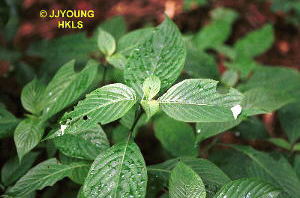 |
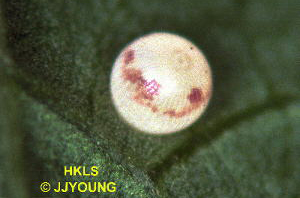 |
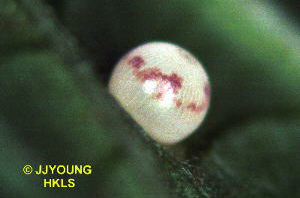 |
| 1, Leaf of hostplant - Eranthernum nervosum (Vahl.)R.br. ex R. & S. with leaf shelters in view |
2, Egg - upper view |
3, Egg - side view |
|
|
|
|
|
|
|
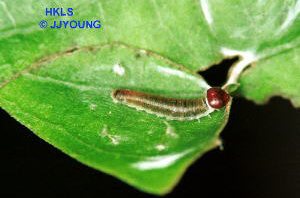 |
 |
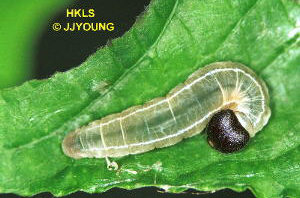 |
| 4, 1st instar larva - side view within leaf shelter |
5, 2nd instar larva - top and side view |
6, 5th instar larva - dorsal view |
|
|
|
|
|
|
|
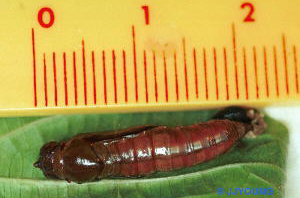 |
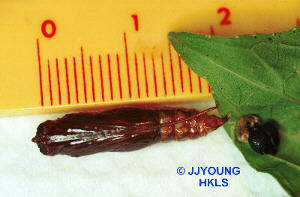 |
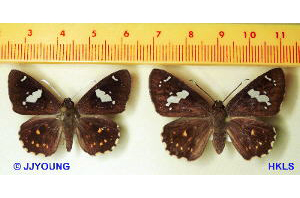 |
| 7, Pupa - dorsal view |
8, Pupa - underside |
9, Adult - male and female - upperside |
|
|
|
|
|
|
|
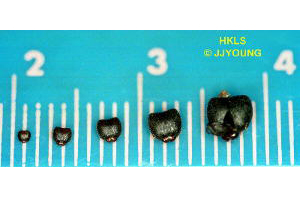 |
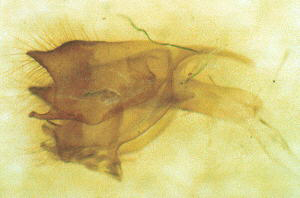 |
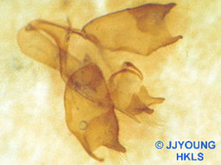 |
| 10, Head capsules of all instars (N.B. scale - one space=1 mm) |
11, Genitalia - male - side view |
12, Genitalia - male - valva in view |
|
|
|
|
|
|
|
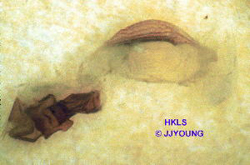 |
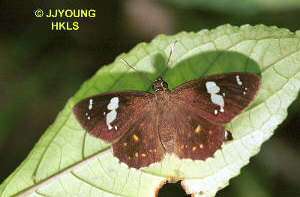 |
|
| 13, Genitalia - female |
14, Adult in motion - female on underside of leaf, Ding Hu Shan, Zhao Qing, China 8th October, 1996 |
|
(Prepared by J.J. Young)
This page was created on 18th December, 2000.
©2004 Hong Kong Lepidopterists' Society Limited
|